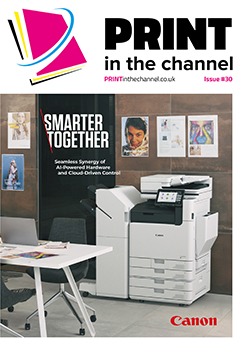Incorporating mobile barcode scanners in warehouses has many advantages for businesses in terms of efficiency and productivity, but these benefits can be lost if the wrong solution is chosen, as Liam Reid, technology and innovation director at The Barcode Warehouse, explains.
There are multiple advantages of incorporating mobile barcode scanners in warehouses. For warehouse customers implementing barcoding technology is important to help remain competitive and future-proof warehouse operations. Even the smallest of warehouses can adopt barcoding technology cost-effectively with a big impact on productivity and scalability.
Barcode scanning can offer multiple levels of improvements and efficiencies across the entire warehouse workflow. One obvious advantage is the increase in mobility and flexibility with use, enabling staff to manage inventory at the source. Barcoding can also enable a much more efficient workforce, speeding up many processes. This helps the business become more profitable, increases staff retention and job fulfilment and makes for an improved and quicker service for customers.
When it comes to data, processes are much more secure, accurate and reliable, with a significant reduction in human errors. Incorrect data inputting costs businesses huge amounts in losses as well as having an impact on customer experiences. It’s these kinds of elements that give organisations that competitive advantage needed in the industry.
Barcode scanning in the warehouse can also create efficiencies across the varied operations that are undertaken in this environment. The elimination of manual and paper-based procedures not only increases productivity but also significantly bolsters data accuracy in critical areas such as stock counts, inventory management and tracking of goods from intake to outgoing shipments. Integration of barcode scanning technology with complementary software and technologies can further elevate quality assurance, ensuring the accurate selection of items for packing and reducing the need for costly return processes.
Crucial factors
We work with warehousing customers of all sizes, and when evaluating preferences for mobile scanners it’s crucial to account for a range of ergonomic factors. In the context of a warehouse environment, enhancing the user experience and minimising the potential for errors hinge on two key aspects: the ease of physical device handling and the seamless integration of the right software with the hardware.
While device speed undoubtedly plays a role in fostering a superior user experience, the paramount factor lies in user-friendliness. Software solutions not only serve as mobile management tools but also help to streamline and automate essential tasks such as inventory management and enterprise resource planning. They provide added value to workers through features like voice-assisted picking and specialised scanning capabilities. Taking a holistic approach to these considerations collectively fosters a swifter and more efficient workforce, ultimately leading to substantial enhancements in business outcomes. The harmonious integration of software with hardware not only optimises operations but also enhances the overall user experience, ensuring that each device is a powerful tool for success in the warehouse environment.
While the performance of mobile scanning technology undoubtedly plays a pivotal role, the importance of selecting the right device for the specific operation cannot be overstated. The market offers a plethora of warehouse scanning solutions, and our recommendation is to trial and test various device forms. Whether its handheld units, devices equipped with trigger handles, or wearable devices, the choice of the device must align seamlessly with the task at hand. The repercussions of selecting the wrong choice of device can lead to lost efficiency gains.
Additionally, the nature of what you’ll be scanning within your warehouse environment should guide your selection. Consider the height, size and distance of the barcodes; these variables will dictate whether you require short-, long- or extended long-range barcode scanners.
The future-proofing aspect of a mobile scanning device warrants careful consideration. Does the customer require a multifunctional device capable of handling tasks like picking, packing and putting away, managing mobile desktop operations running a full suite of MS Office applications, or pairing with a screen and keyboard? Do they need to enhance communication by pairing the device with a headset to facilitate seamless workforce interaction? All these aspects should factor into the decision, along with the assurance that the devices’ operating system will remain viable and adaptable for the business’ needs over the course of three, five or seven years.
Future
Across all industries, the rapid proliferation of digitalisation is evident, and there’s a clear trajectory for its continued expansion. The COVID-19 pandemic served as a catalyst, further accelerating the adoption of digital processes, particularly through the surge in online shopping.
In warehousing, this digital transformation is manifesting in the growing utilisation of RFID solutions. Warehouses today are markedly distinct from their earlier counterparts, with barcode scanning technology becoming more accessible than ever before, available across various requirements and price ranges. This shift mirrors the broader trend, where the necessity of digital solutions and technologies has become a fundamental part of operational strategies.
We are also seeing growing demand for multi-functionality in devices, which has led to streamlined device inventories, with a single device serving multiple purposes. This consolidation allows for the integration of diverse data sets into a unified platform, enhancing efficiency and accessibility.
The integration of IoT devices into supply chains and warehouses is also on the rise. This development will necessitate a greater emphasis on mobile management solutions to facilitate maintenance and monitoring. By proactively managing these devices, warehouses can mitigate the expenses associated with replacement or repairs, ultimately optimising their operational cost-effectiveness.
We anticipate two other significant trends that, intriguingly, counterbalance each other. First, a cohort of businesses will strive to prolong the lifespan of their existing estate of barcode scanners, exploring innovative applications and services for their scanning technology to continually drive efficiency gains.
This shift will spotlight a renewed focus on asset management, ensuring that scanning devices are readily accessible to end users when needed, thus avoiding productivity losses resulting from devices left idle on pallets, in cages or on racks. With this trend, we expect to see a growing awareness of the benefits of partnering with third-party providers that offer enterprise mobility managed services. Managed services can play a pivotal role in optimising an organisation’s mobile device estates to maximise their lifespan. These providers offer a range of services including ongoing maintenance and 24/7 multilingual support, managing buffer stock and proactively monitoring software updates and device utilisation.
Conversely, another segment of businesses still relies on legacy technology, often still utilising the now-unsupported Windows Mobile operating system. It is our prediction that many of these enterprises will recognise the imperative need to migrate away from Windows to the more versatile, secure and future-proof Android operating system. This transition brings the challenge of migrating existing applications to the new platform and focusing on user adoption of the newly deployed technology. However, the potential rewards clearly outweigh any associated risks, as the benefits of this transition promise substantial gains in efficiency and security.










